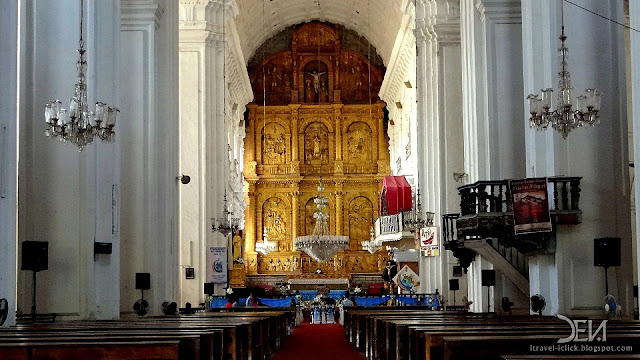Ahh... The last day. Till then, we explored North Goa, had seen the paradise in South Goa, had a cruise ride, then water sports. So the final day was dedicated to explore Old Goa. Anyways, Jishu and Me woke up early and went to Anjuna for a small visit till Judha and Jethu get ready.
Anjuna is a very popular beach in North Goa just above Baga. The golden sands of the beach and the red Laterite rocks create a unique arrangement. Anjuna is known as Freak Capital of the World for the freaking beach parties here held. Now a days, parties are being highly discouraged by authorities. But the full moon parties and the less known black moon parties on the beach is certainly something to go to. These parties sometimes happen in Arambol.
 |
| Sunbatheing of cows at Anjuna Beach |
Anyways, we missed those parties and the famous Flea Market of Anjuna. In between, Jethu called us for breakfast at Baga. We hopped into beach shack at Baga with foreigners sunbathing in front. We converted our breakfast into brunch. before leaving Baga, let's have a small info on Baga.
Baga is the extension of Calangute beach towards north and similarly crowded. It has almost all the facilities that has Calangute. Main attraction is Tito's, an infamous nightspot established in 1971 which attracted many celebs like Beatles, Matt Damon, Richard Gere, Salman Khan, Aishwarya Rai, Sanjay Dutt, Kate Moss etc.
After Judha had the body massage, we started for Old Goa.
 |
| Jethu with "English Breakfast" |
Old Goa is the former colonial capital of Goa. Full of history, it today is home to some scenic churches and convents, that are well maintained and worth a visit. Its Renaissance architecture is breathtaking and the UNESCO has declared it as a World Heritage Site. It was known to the world as Golden Goa or Pearl of the Orient.
The Church and Convent of St. Francis of Assisi was created by the Franciscan friars, eight of whom came to Old Goa in 1517. The Church contiguous to the Convent was demolished in 1661 and rebuilt retaining its old gate made of black stone and exquisitely carved. The interior is heavily gilded with scenes from the bible and the walls have frescoes showing intricate floral designs.
Once you reach Old Goa, the first church on your right hand is Church of St. Francis of Assisi.
Se Cathedral is the largest church in Goa, India and reportedly all Asia. The original building was constructed of mud and stones and straw and was erected in 1510 and was dedicated to St. Catherine for it was on St. Catherine's day -Nov 25th that Alfonso de Albuquerque conquered Goa. It underwent modifications subsequently and a second church was constructed in 1515. The building does not seem very imposing in its outward appearance. But the interior of the Cathedral is majestic and it has a high vaulted ceiling.
The adjacent church to Church of St. Francis of Assisi is Se Cathedral. Both the churches are at the same compound.
Church and Convent of St. Cajetan was build by Italian friars of the order of Theatines in 1640. The Church of St. Cajetan has been modeled after the Basilica of St. Peter's in Rome. The church is dedicated to Our Lady of Divine Providence but is popularly called St. Cajetan, the founder of the Order of Theatines. The convent can be seen standing in front of the church. Today the convent houses the a functioning theological college, the Pius X Pastoral institute.
The church is at behind of Se Cathedral compound.
Beside St. Cajetan church, there's ferry ghat called Divar Ferry covered by painted palm trees.
Basilica of Bom Jesus is the most revered and famous of all the churches in Old Goa. It contains the relics of St. Francis Xavier, Patron saint of Goa, Apostle of the Indies and for most Goans "Goencho Saib". Its construction was begun in 1594 and the church was consecrated in May 1605 by the archbishop, Dom Fr. Aleixo de Menezes. In 1946, it became the first church in India to be elevated to the status of a minor basilica.
The three storey facade, built of black laterite, is a combination of Doric, Corinthian and Composite style architecture. The interior of the Basilica built in the Mosaic-Corinthian style is remarkable for its simplicity.
Once you reach Old Goa, this church is on your right hand.
Convent and Church of St. Augustine now completely in ruins was constructed by 12 Augustinian friars in 1572 immediately after their arrival at Goa. It was reportedly in good shape until it was abandoned in 1835 following the banning of religious orders by the Portuguese government. The church fell into neglect and its vault collapsed in 1842. The facade collapsed on 1931. All that is left today is a bell tower without the bell. The bell was moved to the Fort Aguada Light House initially (1841-1871) and in 1871 was moved to the Church of Our lady of Immaculate Conception at Panaji where it remains functioning to this day.
Opposite to Basilica there's tiny road, through which a 10 minutes walk will take you to the ruins.
We wanted to spend more time in Old Goa, but time's up. Jishu and me wanted to see Dona Paula as well, so I fired up my Impulse and rushed to Dona Paula.
Dona Paula is a secluded bay, nestled on the south side of the rocky, hammer-shaped headland that divides the Zuari and Mandovi estuaries. Dona Paula is known as “Lovers Paradise” which is named after Dona Paula de Menezes.
It's to go home. Jishu, Judha and Jethu... The 3 Js left to catch there buses to Banglore. No matter how late I was, I was still standing on Calangute beach to see the last sunset.
Good bye Goa.

















































